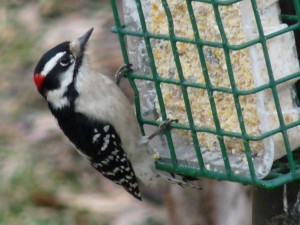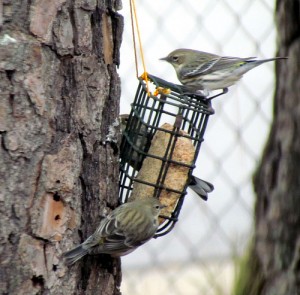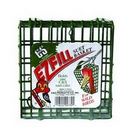Step By Step Instructions for Making Suet for Bird Feeders 
Making Suet For Your Feeders is a Great Family Bonding Activity
This time of year many people choose to feed birds, which is a great way to support local native populations. I don't know about you, but the row after row of seed choices at the hardware store are intimidating. There are a wide variety of seeds available out there to choose from. Black oil sunflower is a favorite, but can be expensive. I've also found that the millet based seed is often just wasted. What you feed the birds really depends on where you live (an apartment manager may not like all the black oil shell husks) and the types of birds you want to feed. I'll cover choosing seeds in a later post, but for now here is a great reference page from the Cornell Lab of Ornithology. Today's post is all about suet, another form of food to feed birds.

Suet has been used as a cooking ingredient for humans for hundreds of years, and more recently for birds. It comes from beef and mutton, and it is a hard white or yellow fat that is found around the kidneys and loins of the animals. Bird suet is "rendered" or cooked down (and the impurities removed) until it reaches a melting point, it is then poured and mixed into a shape, or form, where it hardens. Suet has a fairy low melting point so it's most often used in winter and fall when the temperatures are below zero. Suet can spoil or go rancid quickly, and if it melts it can coat the bird's feathers and "oil" the eggs that the birds sit on, which creates a situation that may kill (or cook) developing eggs. This effect is similar to egg "oiling" used to eradicate invasive species of birds, and we don't want to do that to our beneficial feeder birds! You can read more about egg oiling (addling) here. The nice thing about suet is that children and adults with peanut allergies can make suet blocks (sans peanuts) without worry about allergic reactions. At the hardware store you'll see suet blocks in small square plastic trays. They come in a variety of flavors and with a variety of seeds, corn meal, meal worms, nuts, pepper, and fruit in them.
Why Use Suet?
Suet is attractive to a variety of birds because the fat is a high energy food. The food items that are mixed in with the suet also offer a high energy food source and they are a tempting treat. Suet is a favorite of woodpeckers, chickadees, jay, crows, nuthatches, orioles, cardinals, creepers, wrens, and I've even seen some yellow rump warblers feed on it. A suet block may bring some beautiful birds to your feeder. However, be aware that it can be a draw for some species of bird that you might not want to draw, like starlings and house sparrows or even pesky squirrels. We'll discuss an idea for deterring squirrel below.
What Should I Put on My Shopping List to Make Suet Blocks?
If you want to be an adventurous bird lover, and create your own suet, you'll need some ingredients. Suet fat is easy and cheap to buy. You can pick up a can (8-10 oz) of white Crisco fat/lard at the grocery store or purchase the blocks. You should realize that home-made suet is a bit softer than the suet you buy from the hardware store, because you're using soft fat, however you can add some ingredients to firm it up. It's best not to use bacon or fat drippings because they are not good for birds, and will draw other animals.
Other ingredients to consider mixing in depend on the birds you want to feed.
- Crunchy Peanut Butter- 1-2 tbl sp. Crunchy is better than smooth, because it provides texture. Don't add too much peanut butter, there's some concern about birds getting their beaks stuck together. Ground peanuts or peanut pieces are also great. Be sure that if you're working with peanuts that children and adults around you aren't allergic.
- Cornmeal (White or Yellow) or Ground Almond Meal- 1 cup. Corn meal is obviously cheaper than almond meal so what you choose depends on your budget. You really just need something to bind the suet.
- Black Oil Sunflower Seeds or Millet Seeds- 1 cup (though you may want to experiment.
- Dried Fruit- 1/2-1 cup. You can experiment with the fruit you want to use. Fresh fruit goes rancid rather quickly so it's best to use dried. Pineapple, blueberries, apricots, cranberries, and strawberries are good choices.
- Meal Worms- 1/2-1 cup. You can order dried meal worms in bulk, or pick them up from the hardware store. I know that my local pet store even carry them. Meal worms may attracts some birds that don't traditionally come to feeders, like bluebirds. Dried crickets also work nicely.
- Ground Red Pepper-2-3 tbl. spoons. If you have a problem with squirrles or other mammals you can add ground pepper to the suet to prevent them eating your offering for the birds. It won't bother the birds, but will discolor your suet a bit.
- White Sugar- 4-5 tbl. spoons. Sugar is optional, and can act as a binding agent, but it can also make a bit more sticky texture for your suet.
Tools to Prepare For Making Suet
Now that you have your ingredients you should get your kitchen supplies ready. You'll need the following:
- A saucepan for melting the suet. An old pan that can get greasy is best.
- A wooden spoon for stirring, that you don't mind mixing meal worms, peanut butter, or other ingredients with. A spatula also helps.
- 2-3 suet basket that open from the side (2 x 7.9 x 6.9 inches).
- Wax paper or plastic wrap to line the suet basket.
- Optional: mini food processor or coffee bean grinder.
- Large cookie sheet pan.
- Large bowl optional.
A Note On Containers: You can use almost any type of container for creating suet molds. I've seen heart shapes, cupcake wrappers (aluminum and paper), cat food cans, mini-bread pans,cake bunt pans, and more. The shape is up to you. Kids love fun shapes, and you can leave a hole in the center for hanging your creations with a string. Check out this fun idea for cookie-cutter suet feeders.
Step by Step How to Make Suet
- Prepare your seeds, meal worms, or dried fruit to go into the suet. If you have large pieces of fruit you may need to use a food processor to grind the food into smaller pieces. You want pieces not much larger than sunflower seeds. Don't worry about grinding up the seeds, they can be whole. Whole meal worms are fine too.
- Prepare the mesh suet feeders by placing them on the sheet pan and lining them with wax paper or plastic wrap (this should sit so that you can pour in the liquid fat and not have overflow through the mesh).
- Place the saucepan on your stove top on medium and add the lard or fat. Allow it to melt. Add the peanut butter and stir.
- Take the liquified lard and peanut butter off of the heat. Add the dried ingredients and the chilli powder. You want a consistency that is slightly tacky and difficult to stir. If it is too liquid you can add more bird seed or corn meal. Stirring stiffens the fat. (Some people pour the liquid fat into a separate bowl for this step, but I find it an additional and unnecessary dirty bowl that is hard to clean).
- Pour the suet from the pan into your suet feeder molds.
- Allow the molds to chill either in a cool garage or the fridge until hardened.
- Once the suet is hardened you can take it out of the mold and put it in a feeder to hang outside.
- I like to store my extra suet in the freezer or fridge (if I'm going to use it fairly soon). You can use wax paper to separate the blocks.
There are a wide variety of ways to feed suet. Hanging mesh baskets are popular, but you can also place them on platforms or other flat surfaces, just be aware of deterring unwanted creatures such as squirrels or raccoons.


